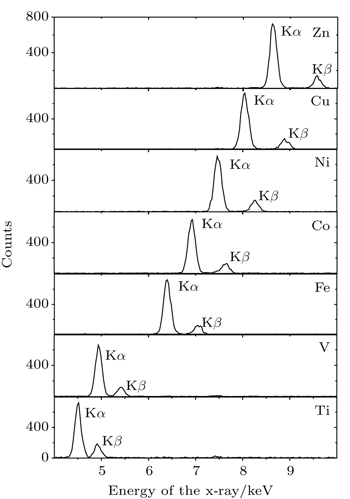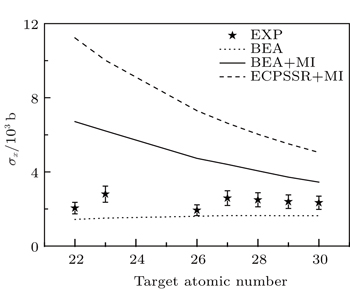† Corresponding author. E-mail:
Project supported by the National Basic Research Program of China (Grant No. 2010CB832902), the National Natural Science Foundation of China (Grant Nos. 11505248, 11375034, U1532263, 11275241, 11205225, 11105192, and 11275238), and the Scientific Research Program of Education Bureau of Shaanxi Province, China (Grant No. 15JK1793).
The K-shell x-rays of Ti, V, Fe, Co, Ni, Cu, and Zn induced by 424-MeV/u C6+ ion impact are measured. It is found that the K x-ray shifts to the high energy side and the intensity ratio of Kβ/Kα is larger than the atomic data, owing to the L-shell multiple-ionization. The x-ray production cross sections are deduced from the experimental counts and compared with the binary encounter approximation (BEA), plane wave approximation (PWBA) and energy-loss Coulomb-repulsion perturbed-stationary-state relativistic (ECPSSR) theoretical predictions. The BEA model with considering the multiple-ionization fluorescence yield is in better consistence with the experimental results. In addition, the cross section as a function of target atomic K-shell binding energy is presented.
Inertial Confinement Fusion (ICF) becomes more and more attractive for energy production in the field of thermonuclear research.[1–3] Two approaches are currently being investigated for heavy ion driven ICF: direct drive and indirect drive.[4] The former study shows that direct drive heavy ion target cannot be achieved through the thermal conduction alone, thus the indirect drive scheme is explored. One of the methods is that the fuel pellet is placed inside a hohlraum made of high-Z material, whose inner wall is heated by ion beams or lasers, and the resulting soft x-ray radiation from the walls drives the implosion with a much higher degree of symmetry.[5] The x-ray radiation drives the implosion, which requires not only sufficient conversion efficiency of the drive energy to the x-ray but also the highly spatial symmetry. Consequently, it is important to investigate the x-ray radiation in the interaction of high energy heavy ions beam with solid target.
The x-ray emission is an important consequential result from the inner-shell ionization during the interaction of highly charged ions with atoms, which provides significant information about atom configuration and the mechanism of such collisions.[6–9] In the middle and low energy region, lots of experimental work has been done on the inner-shell ionization by measuring the x-ray production cross sections, and many successful theories, such as binary encounter approximation (BEA)[10] and plane wave approximation (PWBA)[11] have been established to simulate the process. Especially, the energy-loss Coulomb-repulsion perturbed-stationary-state relativistic (ECPSSR) model,[12] which is a modification of PWBA by considering effects such as energy loss (E) and Coulomb deflection (C) of the projectile, modification of the atomic electron energy states through a perturbed stationary states model and adjustment of the electron mass due to relativistic effects (R), provides an excellent prediction of inner-shell ionization by light ions and has also been successfully applied to asymmetric heavy–ion collision of Z1 < Z2. However, in a very high energy region, it is not unclear that which theory is most suitable to predicting the x-ray emission induced by heavy ions, and the corresponding experimental investigations are rare.[13]
In the present work, the x-ray emission induced by high energy heavy ions is investigated. The K-shell x-ray production cross sections for 424 MeV/u h C6+ ions impacting on selected solid targets (Ti, V, Fe, CO, Ni, Cu, and Zn) are measured. The data are compared with various theoretical calculations of BEA, PWBA, and ECPSSR. The dependence of the cross section on the binding energy is investigated, and compared with that induced by relatively low energy protons.
The experiment was performed at the cancer therapy terminal, which is specially designed for the heavy ion tumor therapy, at the national laboratory of Heavy Ion Research Facility in Lanzhou (HIRFL). The highly charged C6+ ions, produced and extracted from the electron cyclotron resonance (ECR) ion source, are accelerated by the main cooling storage ring (CSRm) with an energy of 430 MeV/u, and the beam quality is improved by the new generation electron cooler. The beam with a duration of 3 s, and a pulse distance of 15 s was directly extracted into air and impacted perpendicularly onto the target after collimation. The actual energy of the projectile impacting on target is about 424 MeV/u, and the corresponding uncertainty of the energies is no more than 0.22%. The beam size is about 5 × 5 mm measured by a CsI(Tl) crystal, and the beam intensity of impacting on the target is about 107 ions/pulse. The x-rays were observed by a silicon drift detector (SDD) which has an effective detection area of 7 mm2 and a 12.5-μm beryllium window in the front of the detector. The SDD was placed at 100 mm away from the target surface and at 135° with respect to the beam direction. The detector had an effective energy range of 0.5 keV–14.3 keV when the gain was selected at 100 and an energy resolution of about 136 eV at 5.9 keV when the peaking time was set to be 9.6 μs. It was calibrated using the standard radioactive resource 55Fe and 241Am before the experiment, and the efficiency was determined by transmission measurements. The targets for V, Co, Ni, Cu, and Zn each have a purity of 99.99%, while the purities of targets for Ti is 98% and 96% for Fe respectively. The thickness values are 4.02, 0.30, 0.10, 23.40, 0.05, 0.60, and 0.02 mm for Ti, V, Fe, Co, Ni, Cu, and Zn targets, respectively. The number of the incident projectiles are measured indirectly by a combination of a Faraday cup and the counts given by the counter fixed around the exit of the beam line terminal. In addition, for comparison, the data of lower energy proton are cited from our previous experiment.[14]
Figure
In Fig.
 | Fig. 2. Comparison of V K-shell x-ray induced by 424 MeV/u C ion impact with that by 200-keV proton impact. |
| Table 1. K-shell x-ray peak positions and relative intensity ratios of Ti, V, Fe, Ni, Cu, and Zn for 424 MeV/u C ion impact. For comparison, the data by proton impact, which are in accordance with the data of the singly ionized atom, are also given. . |
Another effect of multiple-ionization is to change the fluorescence yield. The K-shell vacancy is mainly filled radiatively by x-ray emission or radiativelessly by Auger electron emissions or Coster–Kronig transitions. When the 2p electrons are multiply ionized, the K–L radiation transition rate is reduced because the 2p electrons are directly responsible for the Kα x-ray emission. Moreover, the rate of KLL Auger transition is diminished with the decease of 2p electrons. The total radiative and non-radiative rate are both constant. Thus, the K–M radiative transition rate is enlarged. Consequently, the Kβ fluorescence yield increases as Kα luorescence yield decreases. As listed in column seven in Table
Generally, the observed x-ray cross sections of the thin target can be extracted from the measured x-ray counts, according to formula of σx = Nx/[nNpεdft(Ω/4π)],[17] where n is the target atomic number in unit area. In the present work, the thickness values of the targets are 19.8, 17.0, 18.0, 17.9, 18.8, 21.7, and 28.4 μm for the Kα x-ray of Ti, V, Fe, Co, Ni, Cu, and Zn respectively, which are larger than the self-attenuation length. Thus the thin target cross section formula cannot be used immediately. The energy loss of the projectile in the target with a thickness of self-attenuation length is no more than 0.024 MeV/u, therefore, it is thought that the observed x-rays are induced by the projectiles with the same energy, even though they come from the different atomic layer. Taking the self-absorption of the target and the absorption of the air into account, the experimental x-ray production cross section for the thick target in the high energy region could be calculated from

Table
| Table 2. Target atomic K-shell x-ray production cross sections induced by 424 MeV/u C6+ ion impact on selected targets (Ti ∼ Zn). The unit 1 b = 10−28 m2. . |
As discussed in Subsection 3.1, multiple-ionization is involved in high energy heavy ion-atom collisions. Owing to the appearance of 2p-shell multiple vacancies, some of the non-radiative transitions are forbidden, and the K-shell fluorescence yield is increased. This can, in turn, lead to the enhancement of the x-ray production cross section. The theoretical calculations with considering the fully ionized fluorescence yield are shown in Fig.
The BEA model describes the ion-atom collision as the classical twobody process between the incident ions and the orbital electrons, and simulates the ionization cross section of the inner-shell for a definite energy transfer from the moving particles to the orbital electron of the target atoms and gives that in a close form as[10]

For V < 0.206, the G(V) is approximately expressed as 4V4/15, then the σi is written as[8]

When the scaled velocity is larger than 0.206, the function G(V) can be given algebraically as[18–20]


Generally, the K-shell x-ray production cross section is the result of inner-shell ionization cross section multiplies with the fluorescence yield. Therefore, it has a uniform functional relationship between the ionization cross section and the binding energy. Figure
The K-shell x-ray emissions of the selected elements (Ti–Zn) are investigated for high energy (424 MeV/u) carbon ion impact. The x-ray production cross sections are calculated and compared with various theoretical estimations. It is indicated that in such high energy collisions, the L-shell electrons of the target atoms are multiply ionized, which leads to a blue shift of the K x-ray and an enlargement of the ratio of Kβ to Kα x-ray. The inner-shell ionization induced by high energy heavy ions can be simulated by the BEA model, but the effect of the multiple-ionization should be taken into account when determining the x-ray cross section, which decreases linearly with increasing the target atomic binding energy in the present work.
| 1 | |
| 2 | |
| 3 | |
| 4 | |
| 5 | |
| 6 | |
| 7 | |
| 8 | |
| 9 | |
| 10 | |
| 11 | |
| 12 | |
| 13 | |
| 14 | |
| 15 | |
| 16 | |
| 17 | |
| 18 | |
| 19 | |
| 20 |






